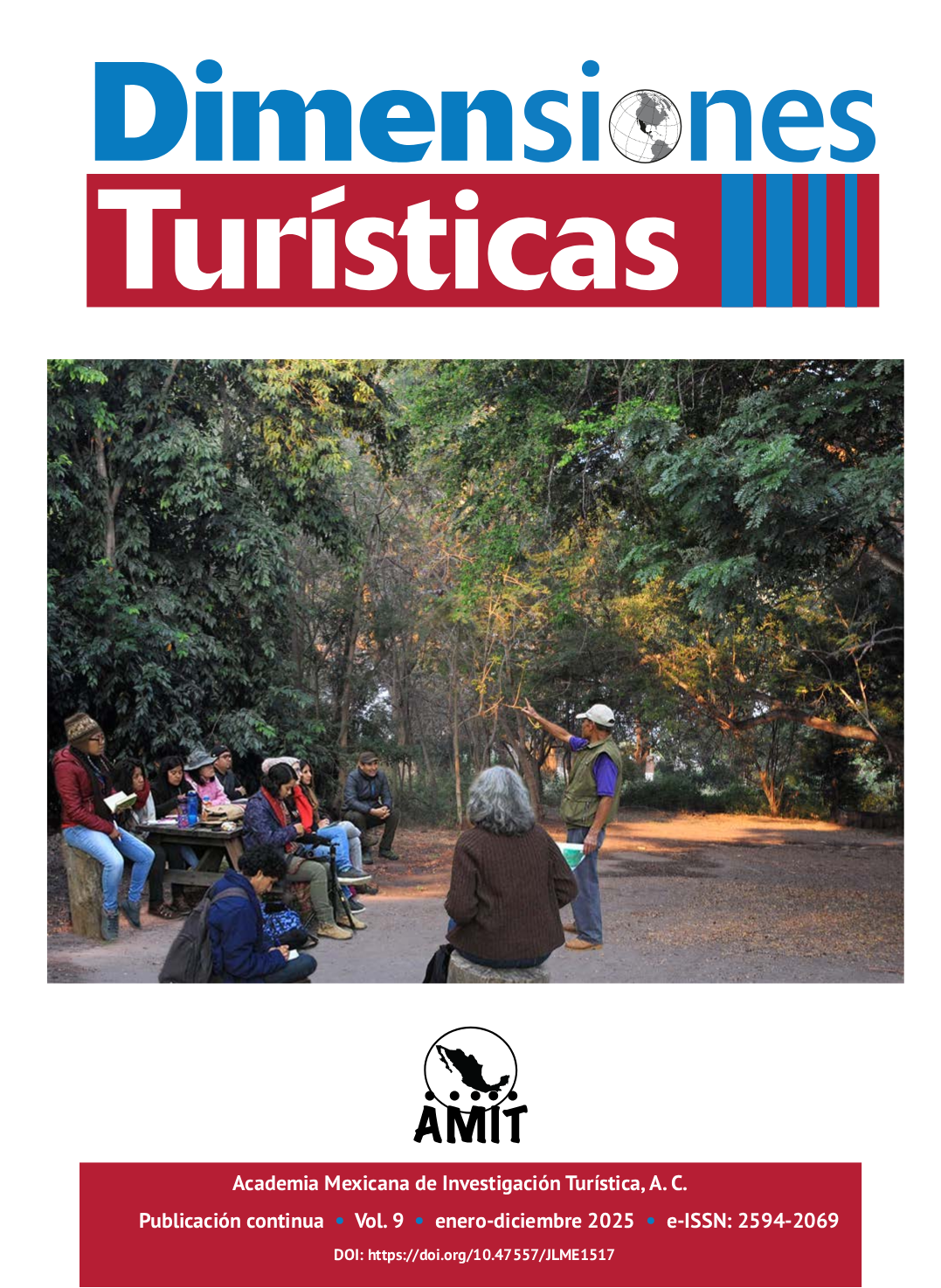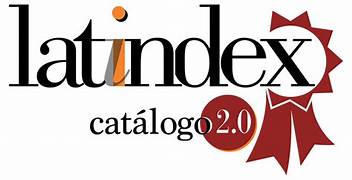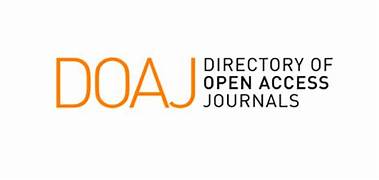Three decades of tourism research in Mexico's protected natural areas: A bibliometric analysis
DOI:
https://doi.org/10.47557/IJDT6606Keywords:
PRISMA, Nature-Based Tourism, Protected Areas, Management, MexicoAbstract
This article analyzes the state of the art of tourism research in Protected Areas (PAd) under state, municipal, and voluntary regimes through the Preferred Reporting Items for Systematic Reviews and Meta-Analyses (PRISMA) method. A total of 24,843 documents were identified in Scopus©, Web of Science©, and Google Scholar; however, only 131 articles met the inclusion criteria for analysis (peer-reviewed, empirical, etc.). The results indicate that the study of tourism in PNAs in Mexico is an emerging field, since although production has been significant in the last decade, the themes and problems show little evolution. Regarding the authors of the articles and collaboration networks, limited links are identified, which infers the difficulty in addressing complex themes and problems of the tourism phenomenon. Therefore, it is recommended to strengthen interdisciplinary and inter-institutional networks through scientific policies that promote co-authorships, creation of regional networks, and funding for projects involving diverse universities. At the same time, academia is urged to broaden the perspective in the study of tourism in PAs.
Downloads
References
Agardy, M. T. (1993). Accommodating ecotourism in multiple use planning of coastal and marine protected areas. Ocean & Coastal Management, 20(3), 219-239. https://doi.org/10.1016/0964-5691(93)90068-A
Almendarez-Hernández, L. C., Rodríguez-Fuentes, M., Vergara-Solana, F. J. y Almendarez-Hernández, M. A. (2020). Economic valuation of sportfishing in the surroundings of Cerralvo Island, Baja California Sur, Mexico using the travel cost method. Latin American Journal of Aquatic Research, 48(3), 370-380. https://doi.org/10.3856/vol48-issue3-fulltext-2379
Barr, R. F. y Mourato, S. (2009). Investigating the potential for marine resource protection through environmental service markets: An exploratory study from La Paz, Mexico. Ocean & Coastal Management, 52(11), 568-577. https://doi.org/10.1016/j.ocecoaman.2009.08.010
Brenner, L. y Job, H. (2012). Challenges to actor-oriented environmental governance: examples from three mexican biosphere reserves. Tijdschrift voor Economische en Sociale Geografie, 103(1), 1-19. https://doi.org/10.1111/j.1467-9663.2011.00671.x
Brenner, L. y Job, H. (2022). Reviewing the participatory management of UNESCO Biosphere Reserves: What do we miss by ignoring local academic knowledge in Mexico? Ambio, 51(7), 1726-1738.
Bringas, N. L. y Ojeda, L. (2000). El ecoturismo: ¿una nueva modalidad del turismo de masas? Economía Sociedad y Territorio https://doi.org/10.22136/est002000436
Cabrera, J. G., Aguilar, C. D. y Arroyo, L. (2024). Ecoturismo en Reservas de la Biosfera de México: una revisión sistemática del estado de conocimiento y problemas de gestión. El Periplo Sustentable, (47), 154 - 177. https://doi.org/10.36677/elperiplo.v0i47.21121
Ceballos Lascuráin, H. (1994). Estrategia Nacional de Ecoturismo para México (Secretaría de Turismo, Ed.). https://cedocvirtual.sectur.gob.mx/janium/Documentos/001928Pri0000.pdf
Comisión Nacional de Áreas Naturales Protegidas (CONANP). (2007). Estrategia Nacional para un Desarrollo Sustentable del Turismo y la Recreaciónen las Áreas Protegidas de México (CONANP, Ed.). https://www.conanp.gob.mx/pdf_publicaciones/TurismoEstrategia.pdf
Comisión Nacional de Áreas Naturales Protegidas (CONANP). (2018). Marco Estratégico de Turismo Sustentable en Áreas Naturales Protegidas de México (CONANP, Ed.). https://www.conanp.gob.mx/acciones/advc/MarcoEstrategico.pdf
Comisión Nacional de Áreas Naturales Protegidas (CONANP). (2024). Áreas Naturales Protegidas. https://www.gob.mx/conanp/documentos/areas-naturales-protegidas-278226
Comisión Nacional de Áreas Naturales Protegidas (CONANP). (2025). Lanzan el proyecto Mex30x30 con inversión récord de 18.5 millones de dólares para apoyar la meta 30x30 en México. https://www.gob.mx/conanp/prensa/lanzan-el-proyecto-mex30x30-con-inversion-record-de-18-5-millones-de-dolares-para-apoyar-la-meta-30x30-en-mexico
Córdoba, M. (2006). Between local and global, discourses and practices: Rethinking ecotourism development in Celestún (Yucatán, México). Journal of Ecotourism, 5(1-2), 97-111. https://doi.org/10.1080/14724040608668449
Cupul-Magaña, A. L. y Rodríguez-Troncoso, A. P. (2017). Tourist carrying capacity at Islas Marietas National Park: An essential tool to protect the coral community. Applied Geography, 88, 15-23. https://doi.org/10.1016/j.apgeog.2017.08.021
Donici, D. S. y Dumitras, D. E. (2024). Nature-Based Tourism in National and Natural Parks in Europe: A Systematic Review. Forests, 15(4), 588. https://doi.org/10.3390/f15040588
García-Frapolli, E., Ayala-Orozco, B., Bonilla-Moheno, M., Espadas-Manrique, C. y Ramos-Fernández, G. (2007). Biodiversity conservation, traditional agriculture and ecotourism: Land cover/land use change projections for a natural protected area in the northeastern Yucatan Peninsula, Mexico. Landscape and Urban Planning, 83(2), 137-153. https://doi.org/10.1016/j.landurbplan.2007.03.007
García-Jácome, L. G., García-Frapolli, E., Bonilla-Moheno, M., Rangel-Rivera, C. E., Benítez, M. y Ramos-Fernández, G. (2020). Multiple Resource Use Strategies and Resilience of a Socio-Ecosystem in a Natural Protected Area in the Yucatan Peninsula, Mexico. Frontiers in Sustainable Food Systems, 4. https://doi.org/10.3389/fsufs.2020.522657
Gössling, S., Scott, D. y Hall, C. M. (2020). Pandemics, tourism and global change: a rapid assessment of COVID-19. Journal of Sustainable Tourism, 29(1), 1-20. https://doi.org/10.1080/09669582.2020.1758708
Hoffman, D. M. (2009). Institutional Legitimacy and Co-Management of a Marine Protected Area: Implementation Lessons from the Case of Xcalak Reefs National Park, Mexico. Human Organization, 68(1), 39-54. https://doi.org/10.17730/humo.68.1.28gw1106u131143h
Lee, A. E. (2014). Territorialisation, Conservation, and Neoliberalism in the Tehuacán-Cuicatlán Biosphere Reserve, Mexico. Conservation and Society, 12(2), 147-161. https://doi.org/10.4103/0972-4923.138413
Liberati, A., Altman, D. G., Tetzlaff, J., Mulrow, C., Gotzsche, P. C., Ioannidis, J. P. A., Clarke, M., Devereaux, P. J., Kleijnen, J. y Moher, D. (2009). The PRISMA statement for reporting systematic reviews and meta-analyses of studies that evaluate healthcare interventions: explanation and elaboration. BMJ, 339(jul21 1), b2700-b2700. https://doi.org/10.1136/bmj.b2700
López, C. P. y Segrado, R. G. (2019). Economic Contribution of Tourism in Tulum National Park. Journal of Tourism and Hospitality Management, 7(2), 85-94. https://doi.org/10.15640/jthm.v7n2a9
Mendoza Ontiveros, M. M., Figueroa Hernández, E. y Godínez Montoya, L. (2015). Turismo comunitario pro-pobre en el ejido El Rosario, Reserva de la Biosfera de la Mariposa Monarca. El Periplo Sustentable, (29), 92-119. https://rperiplo.uaemex.mx/article/view/4907
Moher, D., Liberati, A., Tetzlaff, J. y Altman, D. G. (2009). Preferred reporting items for systematic reviews and meta-analyses: the PRISMA statement. PLoS Medicine, 6(7), e1000097. https://doi.org/10.1371/journal.pmed.1000097
Page, M. J., McKenzie, J. E., Bossuyt, P. M., Boutron, I., Hoffmann, T. C., Mulrow, C. D., Shamseer, L., Tetzlaff, J. M., Akl, E. A., Brennan, S. E., Chou, R., Glanville, J., Grimshaw, J. M., Hróbjartsson, A., Lalu, M. J., Li, T., Loder, E. W., McDonald, S., McGuinness, L. A., . . . Moher, D. (2021). The PRISMA 2020 statement: an updated guideline for reporting systematic reviews. Systematic reviews, 10(1), 1-11. https://doi.org/10.1136/bmj.n71
Palafox-Muñoz, A. y García-Delgado, M. I. (2018). Acumulación por despojo a través del turismo y las áreas naturales protegidas: una mirada a Valle de Bravo, México. Revista Estudios Ambientales, 6(1). https://ojs2.fch.unicen.edu.ar/ojs-3.1.0/index.php/estudios-ambientales/article/view/51
Perez-Verdin, G., Lee, M. E. y Chavez, D. J. (2004). Outdoor recreation in a protected area in Southern Durango, Mexico: analysis of local residents' perceptions. Society & Natural Resources, 17(10), 897-910. https://doi.org/10.1080/08941920490505310
Pérez Ramírez, C., Zizumbo Villarreal, L. y González Vera, M. (2009). Impacto ambiental del turismo en áreas naturales protegidas; procedimiento metodológico para el análisis en el Parque Estatal El Ocotal, México. El Periplo Sustentable, 25-56%N 16. https://rperiplo.uaemex.mx/article/view/5038
Pranckutė, R. (2021). Web of Science (WoS) and Scopus: the titans of bibliographic information in today’s academic world. Publications, 9(1), 12. https://doi.org/10.3390/publications9010012
Reyes-Aguilar, A. K., Pérez-Ramírez, C. A., Serrano-Barquín, R. D. C. y Moreno-Barajas, R. (2019). Turismo rural y conservación ambiental: La participación de la mujer campesina en la Reserva de la Biosfera Los Tuxtlas, Veracruz, México. Rosa dos Ventos, 11(1), 157-177. http://ri.uaemex.mx/handle/20.500.11799/99149
Ríos-Jara, E., Galván-Villa, C. M., Rodríguez-Zaragoza, F. A., López-Uriarte, E. y Muñoz-Fernández, V. T. (2013). The tourism carrying capacity of underwater trails in Isabel Island National Park, Mexico. Environmental Management, 52(2), 335-347. https://doi.org/10.1007/s00267-013-0047-3
Sarhan, M., Pernecky, T., Lück, M. y Orams, M. (2024). Tourism governance and multi-stakeholder partnerships in protected areas: a scoping review. Journal of Park and Recreation Administration, 42(4), 22-39. https://doi.org/10.18666/JPRA-2024-11851
Secretaria de Desarrollo Agrario Territorial y Urbano (SEDATU). (2024). Atlas de la propiedad social de la tierra en México 2024 (1ra. ed.). https://www.gob.mx/ran/documentos/atlas-de-la-propiedad-social
Segrado Pavón, R. G., Serrano-Barquín, R. d. C., Juan Pérez, J. I., Cruz-Jiménez, G. y Arroyo Arcos, L. (2015). Estrategias de competitividad turística en las áreas naturales protegidas de Quintana Roo, México. Investigaciones Turísticas, (9), 1-23. https://doi.org/10.14198/INTURI2015.9.01
Sigala, M. (2020). Tourism and COVID-19: Impacts and implications for advancing and resetting industry and research. Journal of Business Research, 117, 312-321. https://doi.org/10.1016/j.jbusres.2020.06.015
Silva, S., Silva, L. F. y Vieira, A. (2023). Protected areas and nature-based tourism: a 30-year bibliometric review. Sustainability (Switzerland), 15(15), Article 11698. https://doi.org/10.3390/su151511698
Thapa, K., King, D., Banhalmi-Zakar, Z. y Diedrich, A. (2022). Nature-based tourism in protected areas: a systematic review of socio-economic benefits and costs to local people. International Journal of Sustainable Development and World Ecology, 29(7), 625-640. https://doi.org/10.1080/13504509.2022.2073616
Witt, B. (2019). Tourists’ willingness to pay increased entrance fees at Mexican Protected Areas: a multi-site contingent valuation study. Sustainability, 11(11), 3041. https://doi.org/10.3390/su11113041
Ziegler, J., Dearden, P. y Rollins, R. (2012). But are tourists satisfied? Importance-performance analysis of the whale shark tourism industry on Isla Holbox, Mexico. Tourism Management, 33(3), 692-701. https://doi.org/10.1016/j.tourman.2011.08.004
Published
How to Cite
Issue
Section
License
Copyright (c) 2025 Julisa Guadalupe Cabrera Borraz, Ludger Brenner, Daniel Vargas del Río

This work is licensed under a Creative Commons Attribution-NonCommercial-ShareAlike 4.0 International License.
All contents of Dimensiones Turísticas are published under the Attribution/Attribution - non-commercial - sharealike 4.0 International license, and can be used free of charge for non-commercial purposes, giving credit to the authors and the Dimensiones Turísticas journal. Articles before January-December 2023 were published under Attribution/Attribution - Non-Commercial - NoDerivatives 4.0 International License.











